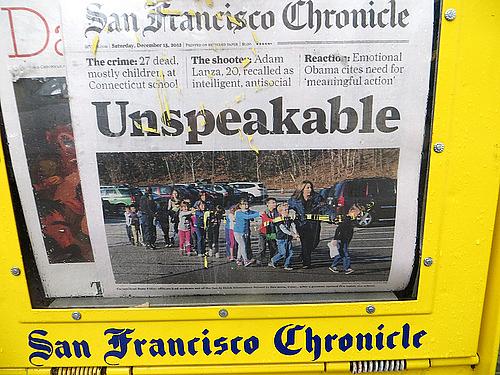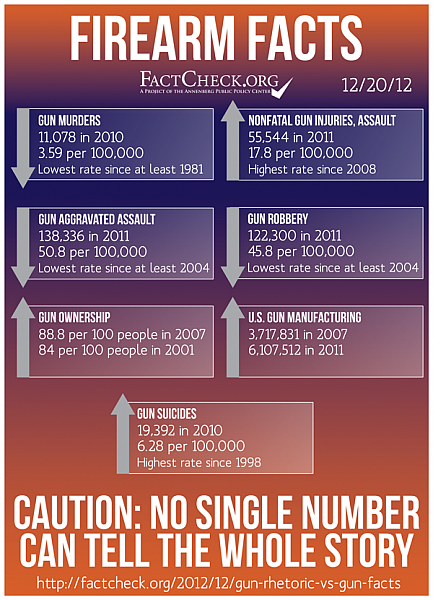Preventing Gun Violence: Where are the Data?

Most health reporters love data. A compelling patient or researcher makes a story engaging; concrete statistics make a story valid.
Data, however, aren’t always clear-cut or concrete, and experts disagree on how to interpret the numbers and apply them to treatment or policy. One example of this divide in medicine is the age at which a woman should start routine mammograms.
Not surprisingly, statistics on gun violence and how to reduce it fall prey to the same dichotomy. There’s a critical mass of stories that could affect gun policy in the news this week -- Vice President Joe Biden’s gun safety task force; the preliminary hearing for last summer’s deadly Colorado movie shooting; gun control legislation circulating around a new Congress; and the one-month anniversary of the Sandy Hook Elementary School shooting approaching -- so here are a few things to keep in mind when using statistics from any side of the debate.
“Data on Firearms and Violence Too Weak to Settle Policy Debates; Comprehensive Research Effort Needed”: That was a press release headline from a 2004 publication by the National Research Council called Firearms and Violence: A Critical Review. Here’s more from the report’s Executive Summary explaining the assertion:
The committee found that answers to some of the most pressing questions cannot be addressed with existing data and research methods, however well designed. For example, despite a large body of research, the committee found no credible evidence that the passage of right-to-carry laws decreases or increases violent crime, and there is almost no empirical evidence that the more than 80 prevention programs focused on gun-related violence have had any effect on children’s behavior, knowledge, attitudes, or beliefs about firearms. The committee found that the data available on these questions are too weak to support unambiguous conclusions or strong policy statements.
Not much has changed, nearly a decade later, according to a Wall Street Journal article by Joe Palazzolo and Carl Bialik:
Federal data on gun ownership have dwindled and public funding for gun research has all but dried up. Private foundations, with few exceptions, have left the field. Underreported crime figures and inconsistent enforcement of gun laws further frustrate analysis. Researchers say they don't have access to enough data to draw firm conclusions.
One of those researchers, Akiva Liberman, a social psychologist and a senior fellow at the Urban Institute's Justice Policy Center in Washington, D.C., told the Journal, "The sad truth is that in the United States, the quality of data on crime is pathetic.”

- On the assertion that states with conceal carry laws have lower rates of violent crimes, FactCheck.org writes: “The bottom line … is that the issue is much too unsettled for such a definitive claim.” The post offers an extensive look at both sides of this argument.
- On the issue of more guns in an area causing more gun deaths, FactCheck.org writes: “[S]ome studies had shown a statistical relationship between those factors -- areas with a higher prevalence of guns had higher prevalence of gun homicides and homicides in general. But studies haven’t been able to show a causal relationship -- that the mere presence of guns, as opposed to other factors, caused the higher rates of gun violence.”
- On trends showing there are more guns in the U.S. than before: There’s disagreement if more people buying guns or the same people buying more guns.
- On comparing the U.S. with other countries: “One problem in comparing various countries is the wealth of other factors, besides the mere presence of guns, that can affect whether a homicide occurs, such as the economy, general crime rates, and laws governing guns. Another issue is that the data isn’t all that great. Gun ownership numbers are largely based on public opinion surveys, and the reliability of numbers can vary widely from country to country.”
Another interesting data note that has to do with the background checks required for guns bought from a dealer. Guns bought from a private seller do not involve a background check.
Last summer the Government Accountability Office (GAO) looked at the background checks -- National Instant Criminal Background Check System (NICS) -- used to flag people with mental illness and prior drug arrests. GAO found that between 2004 and 2011 there was an increase in quantity of mental health records and the number of states that sent them to the database:
This increase largely reflects the efforts of 12 states. However, almost half of all states increased the number of mental health records they made available by fewer than 100 over this same time period. Technological, legal, and other challenges limited the states’ ability to share mental health records. … The states’ overall progress in making unlawful drug use records available to NICS is generally unknown because of how these records are maintained. The vast majority of records made available are criminal records—such as those containing arrests or convictions for possession of a controlled substance -- which cannot readily be disaggregated from other records in the databases checked by NICS.
So even the data used to process the background checks clearly needs some work.
Graphic courtesy of FactCheck.org
Image by torbakhopper via Flickr

